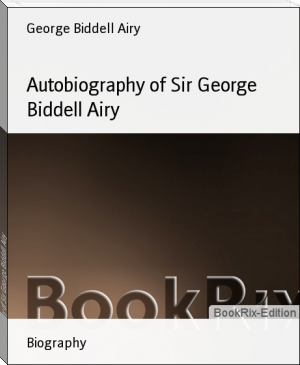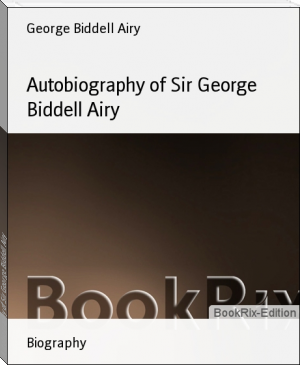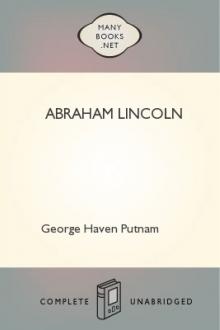Autobiography of Sir George Biddell Airy by George Biddell Airy (e reader for manga .TXT) 📕

- Author: George Biddell Airy
Book online «Autobiography of Sir George Biddell Airy by George Biddell Airy (e reader for manga .TXT) 📕». Author George Biddell Airy
little, inferior to those of the Meridional Instruments. I consider that the object for which this instrument was erected is successfully attained.'--Being satisfied with the general efficiency of the system arranged by Mr Brooke for our photographic records (of magnetical observations) I wrote to the Admiralty in his favour, and on Aug. 25th the Admiralty ordered the payment of L500 to him. A Committee of the Royal Society also recommended a reward of L250 to Mr Ronalds, which I believe was paid to him.--On May 1st the last revise of the Lunar Reductions was passed, and on May 5th, 500 copies were sent for binding.--In this year Schumacher and I refused a medal to Miss Mitchell for a Comet discovered, because the rules of correspondence had not been strictly followed: the King of Denmark gave one by special favour.--In this year occurred the discovery of Saturn's 8th Satellite by Mr Lassell: upon which I have various correspondence.--On the 18th of December the degree of LL.D. was conferred upon me by the University of Edinburgh.--The Ipswich Lectures: A wish had been expressed that I would give a series of Astronomical Lectures to the people of Ipswich. I therefore arranged with great care the necessary apparatus, and lectured six evenings in a room (I forget its name--it might be Temperance Hall--high above St Matthew's Street), from Mar. 13th to the end of the week. A shorthand writer took them down: and these formed the 'Ipswich Lectures,' which were afterwards published by the Ipswich Museum (for whose benefit the lectures were given) and by myself, in several editions, and afterwards by Messrs Macmillan in repeated editions under the title of 'Airy's Popular Astronomy.'--It had been found necessary to include under one body all the unconnected Commissions of Sewers for the Metropolis, and Lord Morpeth requested me to be a member. Its operations began on Oct. 28th. In constitution it was the most foolish that I ever knew: consisting of, I think, some 200 persons, who could not possibly attend to it. It came to an end in the next year."
Of private history: "I was at Playford from Jan. 1st to 11th, and again from Jan. 17th to 25th: also at Playford from June 21st to July 12th.--From Aug. 23rd to Sept. 12th I was in Ireland on a visit to Lord Rosse at Parsonstown, chiefly engaged on trials of his large telescope. I returned by Liverpool, where I inspected the Liverpool Equatoreal and Clockwork, and examined Mr Lassell's telescopes and grinding apparatus.--From Dec. 6th to 20th I was at Edinburgh with my wife, on a visit to Prof. J. D. Forbes. We made various excursions, and I attended lectures by Prof. Wilson and Sir W. Hamilton: on the 18th I gave a lecture in Prof. Forbes's room. I received the Honorary Degree of LL.D., and made a statement on the Telescopes of Lord Rosse and Mr Lassell to the Royal Society of Edinburgh. Returned to Greenwich by Brampton."
* * * * *
Here is a reminiscence of the "Ipswich Lectures," in a letter to his wife, dated Playford, 1848 Mar. 14, "At the proper time I went to the hall: found a chairman installed (Mr Western): was presented to him, and by him presented to the audience: made my bow and commenced. The room was quite full: I have rarely seen such a sea of faces; about 700 I believe. Everything went off extremely well, except that the rollers of the moving piece of sky would squeak: but people did not mind it: and when first a star passed the meridian, then Jupiter, then some stars, and then Saturn, he was much applauded. Before beginning I gave notice that I should wait to answer questions: and as soon as the lecture was finished the Chairman repeated this and begged people to ask. So several people did ask very pertinent questions (from the benches) shewing that they had attended well. Others came up and asked questions."
* * * * *
The following extracts are from letters written to his wife while on his visit to Lord Rosse at Parsonstown in Ireland. On the way he stopped at Bangor and looked at the Tubular Bridge Works, which are thus referred to: "Stopped at Bangor, settled pro tem . at the Castle, and then walked past the Suspension Bridge towards the Tube Works, which are about 1-1/2 mile south-west of the Suspension Bridge. The way was by a path through fields near the water side: and from one or two points in this, the appearance of the Suspension Bridge was most majestic. The Tube Bridge consists of four spans, two over water and two over sloping land. The parts for the double tube over the water spans (four lengths of tube) are building on a platform as at Conway, to be floated by barges as there: the parts over the sloping banks are to be built in their place, on an immense scaffolding. I suspect that, in regard to these parts, Stephenson is sacrificing a great deal of money to uniformity of plan: and that it would have been much cheaper to build out stone arches to the piers touching the water.... The Tube Works are evidently the grand promenade of the idlers about Bangor: I saw many scores of ladies and gentlemen walking that way with their baskets of provision, evidently going to gipsy in the fields close by."
THE CASTLE, PARSONSTOWN,
1848, Aug. 29 .
After tea it was voted that the night was likely to be fine, so we all turned out. The night was uncertain: sometimes entirely clouded, sometimes partially, but objects were pretty well seen when the sky was clear: the latter part was much steadier. From the interruption by clouds, the slowness of finding with and managing a large instrument (especially as their finding apparatus is not perfectly arranged) and the desire of looking well at an object when we had got it, we did not look at many objects. The principal were, Saturn and the Annular Nebula of Lyra with the 3-feet; Saturn, a remarkable cluster of stars, and a remarkable planetary nebula, with the 6-feet. With the large telescope, the evidence of the quantity of light is prodigious. And the light of an object is seen in the field without any colour or any spreading of stray light: and it is easy to see that the vision with a reflecting telescope may be much more perfect than with a refractor. With these large apertures, the rings round the stars are insensible. The planetary nebula looked a mass of living and intensely brilliant light: this is an object which I do not suppose can be seen at all in our ordinary telescopes. The definition of the stars near the zenith is extremely good: with a high power (as 800) they are points or very nearly so--indeed I believe quite so--so that it is clear that the whole light from the great 6-feet mirror is collected into a space not bigger than the point of a needle. But in other positions of the telescope the definition is not good: and we must look to-day to see what is the cause of this fault. It is not a fault in the telescope, properly so-called, but it is either a tilt of the mirror, or an edge-pressure upon the mirror when the telescope points lower down which distorts its figure, or something of that kind. So I could not see Saturn at all well, for which I was sorry, as I could so well have compared his appearance with what I have seen before. I shall be very much pleased if we can make out what is the fault of adjustment, and so correct it as to get good images everywhere. It is evident that the figuring of the mirror, the polishing, and the general arrangement, are perfectly managed.
THE CASTLE, PARSONSTOWN,
1848, Aug. 30 .
Yesterday we were employed entirely about the Great Telescope, beginning rather late. The principal objects had relation to the fault of definition when the telescope is pointed low (which I had remarked on the preceding night), and were, to make ourselves acquainted with the mechanism of the mirror's mounting generally, and to measure in various ways whether the mirror actually does shift its place when the telescope is set to different angles of elevation. For the latter we found that the mirror actually does tilt 1/4 of an inch when the tube points low. This of itself will not account for the fault but it indicates that the lower part is held fast in a way that may cause a strain which would produce the fault. These operations and reasonings took a good deal of time. Lord Rosse is disposed to make an alteration in the mounting for the purpose of correcting this possible strain.
THE CASTLE, PARSONSTOWN,
1848, Aug. 31 .
The weather here is still vexatious: but not absolutely repulsive. Yesterday morning Lord Rosse arranged a new method of suspending the great mirror, so as to take its edgewise pressure in a manner that allowed the springy supports of its flat back to act. This employed his workmen all day, so that the proposed finish of polishing the new mirror could not go on. I took one Camera Lucida sketch of the instrument in the morning, dodging the heavy showers as well as I could; then, as the afternoon was extremely fine, I took another, with my head almost roasted by the sun. This last view is extremely pretty and characteristic, embracing parts of the mounting not shewn well in the others, and also shewing the Castle, the Observatory, and the 3-feet telescope.
Of private history: "I was at Playford from Jan. 1st to 11th, and again from Jan. 17th to 25th: also at Playford from June 21st to July 12th.--From Aug. 23rd to Sept. 12th I was in Ireland on a visit to Lord Rosse at Parsonstown, chiefly engaged on trials of his large telescope. I returned by Liverpool, where I inspected the Liverpool Equatoreal and Clockwork, and examined Mr Lassell's telescopes and grinding apparatus.--From Dec. 6th to 20th I was at Edinburgh with my wife, on a visit to Prof. J. D. Forbes. We made various excursions, and I attended lectures by Prof. Wilson and Sir W. Hamilton: on the 18th I gave a lecture in Prof. Forbes's room. I received the Honorary Degree of LL.D., and made a statement on the Telescopes of Lord Rosse and Mr Lassell to the Royal Society of Edinburgh. Returned to Greenwich by Brampton."
* * * * *
Here is a reminiscence of the "Ipswich Lectures," in a letter to his wife, dated Playford, 1848 Mar. 14, "At the proper time I went to the hall: found a chairman installed (Mr Western): was presented to him, and by him presented to the audience: made my bow and commenced. The room was quite full: I have rarely seen such a sea of faces; about 700 I believe. Everything went off extremely well, except that the rollers of the moving piece of sky would squeak: but people did not mind it: and when first a star passed the meridian, then Jupiter, then some stars, and then Saturn, he was much applauded. Before beginning I gave notice that I should wait to answer questions: and as soon as the lecture was finished the Chairman repeated this and begged people to ask. So several people did ask very pertinent questions (from the benches) shewing that they had attended well. Others came up and asked questions."
* * * * *
The following extracts are from letters written to his wife while on his visit to Lord Rosse at Parsonstown in Ireland. On the way he stopped at Bangor and looked at the Tubular Bridge Works, which are thus referred to: "Stopped at Bangor, settled pro tem . at the Castle, and then walked past the Suspension Bridge towards the Tube Works, which are about 1-1/2 mile south-west of the Suspension Bridge. The way was by a path through fields near the water side: and from one or two points in this, the appearance of the Suspension Bridge was most majestic. The Tube Bridge consists of four spans, two over water and two over sloping land. The parts for the double tube over the water spans (four lengths of tube) are building on a platform as at Conway, to be floated by barges as there: the parts over the sloping banks are to be built in their place, on an immense scaffolding. I suspect that, in regard to these parts, Stephenson is sacrificing a great deal of money to uniformity of plan: and that it would have been much cheaper to build out stone arches to the piers touching the water.... The Tube Works are evidently the grand promenade of the idlers about Bangor: I saw many scores of ladies and gentlemen walking that way with their baskets of provision, evidently going to gipsy in the fields close by."
THE CASTLE, PARSONSTOWN,
1848, Aug. 29 .
After tea it was voted that the night was likely to be fine, so we all turned out. The night was uncertain: sometimes entirely clouded, sometimes partially, but objects were pretty well seen when the sky was clear: the latter part was much steadier. From the interruption by clouds, the slowness of finding with and managing a large instrument (especially as their finding apparatus is not perfectly arranged) and the desire of looking well at an object when we had got it, we did not look at many objects. The principal were, Saturn and the Annular Nebula of Lyra with the 3-feet; Saturn, a remarkable cluster of stars, and a remarkable planetary nebula, with the 6-feet. With the large telescope, the evidence of the quantity of light is prodigious. And the light of an object is seen in the field without any colour or any spreading of stray light: and it is easy to see that the vision with a reflecting telescope may be much more perfect than with a refractor. With these large apertures, the rings round the stars are insensible. The planetary nebula looked a mass of living and intensely brilliant light: this is an object which I do not suppose can be seen at all in our ordinary telescopes. The definition of the stars near the zenith is extremely good: with a high power (as 800) they are points or very nearly so--indeed I believe quite so--so that it is clear that the whole light from the great 6-feet mirror is collected into a space not bigger than the point of a needle. But in other positions of the telescope the definition is not good: and we must look to-day to see what is the cause of this fault. It is not a fault in the telescope, properly so-called, but it is either a tilt of the mirror, or an edge-pressure upon the mirror when the telescope points lower down which distorts its figure, or something of that kind. So I could not see Saturn at all well, for which I was sorry, as I could so well have compared his appearance with what I have seen before. I shall be very much pleased if we can make out what is the fault of adjustment, and so correct it as to get good images everywhere. It is evident that the figuring of the mirror, the polishing, and the general arrangement, are perfectly managed.
THE CASTLE, PARSONSTOWN,
1848, Aug. 30 .
Yesterday we were employed entirely about the Great Telescope, beginning rather late. The principal objects had relation to the fault of definition when the telescope is pointed low (which I had remarked on the preceding night), and were, to make ourselves acquainted with the mechanism of the mirror's mounting generally, and to measure in various ways whether the mirror actually does shift its place when the telescope is set to different angles of elevation. For the latter we found that the mirror actually does tilt 1/4 of an inch when the tube points low. This of itself will not account for the fault but it indicates that the lower part is held fast in a way that may cause a strain which would produce the fault. These operations and reasonings took a good deal of time. Lord Rosse is disposed to make an alteration in the mounting for the purpose of correcting this possible strain.
THE CASTLE, PARSONSTOWN,
1848, Aug. 31 .
The weather here is still vexatious: but not absolutely repulsive. Yesterday morning Lord Rosse arranged a new method of suspending the great mirror, so as to take its edgewise pressure in a manner that allowed the springy supports of its flat back to act. This employed his workmen all day, so that the proposed finish of polishing the new mirror could not go on. I took one Camera Lucida sketch of the instrument in the morning, dodging the heavy showers as well as I could; then, as the afternoon was extremely fine, I took another, with my head almost roasted by the sun. This last view is extremely pretty and characteristic, embracing parts of the mounting not shewn well in the others, and also shewing the Castle, the Observatory, and the 3-feet telescope.
Free e-book «Autobiography of Sir George Biddell Airy by George Biddell Airy (e reader for manga .TXT) 📕» - read online now
Similar e-books:





Comments (0)